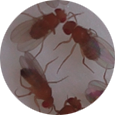Defining the role of circadian genes in behavioral sensitization to psychostimulants in Drosophila melanogaster
Funding Agency:
Croatian Science foundation, Project: HRZZ IP-11-2013-4920
Principal Investigator:
Dr.sc. Rozi Andretić Waldowski (Head of the Laboratory for Behavioral Genetics, Department of Biotechnology, University of Rijeka, Croatia)
Host Institution:
Department of Biotechnology, University of Rijeka, Croatia
Team:
Ana Filošević, PhD student, Department of Biotechnology, University of Rijeka, Croatia
Maja Badurina, PhD student, Department of Biotechnology, University of Rijeka, Croatia
Prof. Ralph J. Greenspan, University of California San Diego, CA, USA
Collaborators:
Ivan Odak, MS student, Department of Biotechnology, University of Rijeka, Croatia (2014-2015)
Project duration:
September 2014 – August 2017
Laboratory for behavioral genetics:
http://www.andreticlab.uniri.hr/en/
Project Summary:
Addiction to drugs is a brain disease characterized by changes in the brain functioning caused by repeated drug taking. Repeated drug taking leads to neuroadaptations which over time affect neural networks and change behavior. One such change induced by drugs and commonly studied in lab animals is behavioral sensitization. Regulation of gene expression is one important mechanism by which drugs change the plasticity of the networks which regulate behavior. A group of transcriptional regulators of the molecular circadian clock have been identified to function as regulators of behavioral sensitization to cocaine in Drosophila. Subsequent studies in rodents proved the universality of those genes in mediating drug responses. The genetic pathways and molecular interactions through which circadian genes regulate drug responses has remained undefined. We hypothesize that new genes which interact with circadian genes in the regulation of behavioral sensitization to psychostimulants can be identified in a genetic screen in Drosophila. This is a goal for which Drosophila is perfectly suited, because genetic screens aimed at defining new genes can be performed relatively easy, fast and cheap. Our first aim is to devise a high-throughput method for measuring behavioral sensitization in flies by modifying the existing method for measuring activity. Second, we will undertake a directed behavioral screen by pre-selecting candidates with reported molecular interaction with circadian genes. In the third aim we will use transgenic flies and other genetic tools to investigate neural mechanisms involved in behavioral sensitization. The proposed research is innovative and relevant for human health. New gene candidates isolated in this screen could easily be translated into mammalian research where they will help in further understanding of neuroplastic changes induced by psychostimulants. Given our expertise and available resources the project has great potential to advance the field.
Aims:
First aim:
Currently there are no high-throughput tests for behavioral sensitization in Drosophila which can be used in a behavioral screen to identify new genes. The first aim of our project is to develop such a test. To do that we are using the existing technology for measuring locomotor activity of flies during 24 hours, the Drosophila Activity Monitoring System (DAMS). We define behavioral sensitization as significant increase in locomomtor activity after repeated administration of the same drug concentration.
Behavioral sensitization has previously been demonstrated in Drosophila using volatilized cocaine, using a protocol that is not amenable to screning. Effects of methamphetamine (METH) have been recorded in DAMS where it has locomotor activating, and arousing properties. Sensitizing flies using METH has not been attempted before.
We show that acute 12 hrs administration of either cocaine or METH leads to does-dependent increase in locomotor activity and decrease in sleep. In order to induce behavioral sensitization we vary concentration of the drugs, length and time of the exposure, and in some instances combine it with previous starvation METH induces more reliable increase only in locomotor behavior and seems to be better suited for induction of behavioral sensitization using DAMS. We have defined the protocol to successfully induce behavioral sensitization to METH using DAMS.
Second aim:
We will use the protocol for behavioral sensitization in a directed genetic screen to identify new genes. Previously it was shown that behavioral sensitization to volatilized cocaine in Drosophila requires three circadian genes: period (per), Clock (Clk) and cycle (cyc). Similarly in rodents their monologues: mPeriod1 and mPeriod2 (mPer1 and mPer2), mClock (mClk) and BMAL1 are required for behavioral sensitization to cocaine, but also other drug responses to opiates and alcohol.
In our behavioral screen we will test flies mutant for genes whose physical interaction was previously established based on genetic and molecular methods. This will increase the likelihood of a positive hit, in a relatively short time frame. The identification of a relevant gene is high, because we will screen only genes wich have established physical interaction with three circadian genes.
Third aim:
Candidates which we identify in a behavioral screen will then be characterized for their role in the process of behavioral sensitization. We will investigate two issues: identification of neurons in which the presence of the gene is permissive for development of sensitization and interaction with the dopaminergic system. Previous work has shown requirement for a dopaminergic receptor dDA1 in the group of neurons called Mushroom bodies for the arousing effect of methamphetamine. It is unknown where in the brain circadian genes are required for the behavioral sensitization to cocaine. However, repeated cocaine administration leads to modulation od dDA2 class of dopamine receptor and this modulation is dependent on functional copy of per gene.

